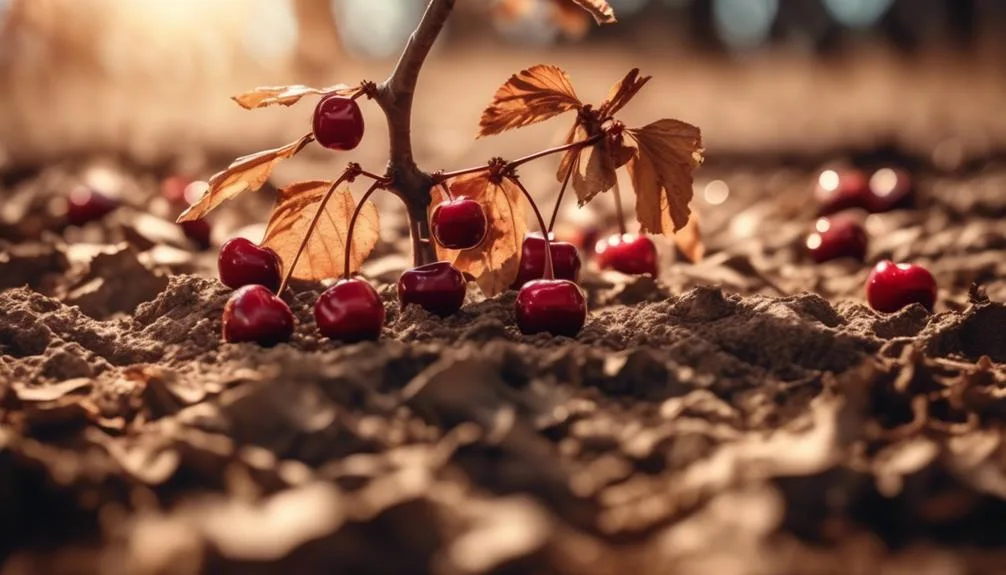The impact of climate change on cherry trees goes beyond the beauty of their blossoms. It could affect tree growth, fruit yield, and conservation efforts.
Understanding this issue is crucial.
Cherry Blossom Phenology
Cherry blossom phenology, the study of the timing of cherry tree blooming and fruiting, provides crucial insights into the impacts of climate change on these iconic trees.
Climate change's effect on cherry blossom timing is a significant concern as rising temperatures can cause earlier blooming, disrupting the delicate balance of ecosystems that rely on these blossoms.
Cherry trees have developed adaptation strategies, such as adjusting their blooming time in response to temperature changes, but rapid shifts in climate may challenge these mechanisms.
Understanding these adaptation strategies can help researchers and arborists develop proactive measures to protect cherry tree populations.
Impact on Cherry Tree Growth
Rising temperatures and changing precipitation patterns directly impact the growth and development of cherry trees, influencing their overall health and productivity. Here's how climate change is affecting cherry tree growth:
- Temperature sensitivity affects the timing of bud burst and flowering, potentially leading to mismatches with pollinators and reducing fruit set.
- Changes in growth patterns, such as accelerated shoot elongation and altered dormancy periods, can disrupt the tree's natural cycles.
- Variations in soil moisture levels impact root development and nutrient uptake, influencing overall tree vigor and fruit quality.
- Increased frequency of extreme weather events, such as heatwaves or intense storms, can cause physical damage to trees and disrupt their growth patterns.
These factors collectively pose significant challenges to the growth and sustainability of cherry trees in the face of climate change.
Cherry Tree Diseases and Pests
Experiencing a surge in temperatures and changing precipitation patterns, cherry trees face increased vulnerability to a range of diseases and pests, impacting their overall health and productivity. Fungal infections and aphid infestations are major concerns for cherry trees, especially when coupled with environmental stressors. These issues can significantly impact tree health, leading to reduced fruit production and overall tree vigor.
| Diseases and Pests | Impact on Cherry Trees |
|---|---|
| Fungal Infections | Weaken tree's immune system and cause leaf and fruit damage. |
| Aphid Infestations | Sap-sucking insects that can cause leaf curling, yellowing, and reduce tree growth. |
It's essential to monitor and manage these diseases and pests to ensure the longevity and productivity of cherry trees in the face of changing climatic conditions.
Cherry Tree Fruit Yield
With changing climate conditions, ensuring optimal fruit yield from cherry trees requires proactive management of environmental stressors and the implementation of effective cultivation practices. When it comes to cherry tree fruit yield, there are several key factors to consider:
- Pollination Challenges: Erratic weather patterns and extreme temperatures can disrupt pollination, impacting fruit set and overall yield.
- Weather Extremes: Extreme weather events such as late frosts or heatwaves can damage blossoms, reducing the potential fruit yield.
- Fruit Quality: Climate fluctuations can affect fruit size, flavor, and ripening, influencing the overall quality of the yield.
- Reproduction Success: Changes in climate can impact the trees' reproductive success, potentially leading to reduced fruit yield.
Cherry Tree Conservation Efforts
To ensure the preservation and sustainability of cherry trees, proactive conservation efforts are essential in mitigating the impact of changing climate conditions on their growth and longevity. One crucial aspect of cherry tree conservation is maintaining genetic diversity. By preserving a wide range of genetic traits within cherry tree populations, scientists can promote climate adaptation and resilience. Another important conservation effort is the establishment of protected areas and conservation programs that aim to safeguard wild cherry tree populations. These initiatives not only protect the trees themselves but also the ecosystems they inhabit. Lastly, educating the public about the significance of cherry trees and the threats they face can inspire greater participation in conservation efforts. Together, these actions contribute to the long-term survival of cherry trees in the face of climate change.
| Conservation Effort | Impact |
|---|---|
| Genetic Diversity Preservation | Promotes climate adaptation |
| Establishment of Protected Areas | Safeguards wild populations |
| Public Education | Inspires conservation participation |
Conclusion
In the face of climate change, the impact on cherry trees is undeniable. As we witness shifts in growth patterns and increased vulnerability to pests, safeguarding these trees becomes imperative.
By acknowledging the threat posed by climate change and taking proactive measures, we can ensure the preservation of cherry trees for future generations.

My interest in trees started when I first saw the giant sequoias in Yosemite.
I was a teenager then, and I remember thinking, “I need to learn more about this.”
That moment stuck with me.
A few years later, I went on to study forestry at Michigan Tech.
Since graduating, I’ve worked in a mix of hands-on tree care and community education.
I’ve spent over ten years helping people understand how to plant, maintain, and protect the trees in their neighborhoods.
I don’t see trees as just part of the landscape.
They are living things that make a real difference in our daily lives.
